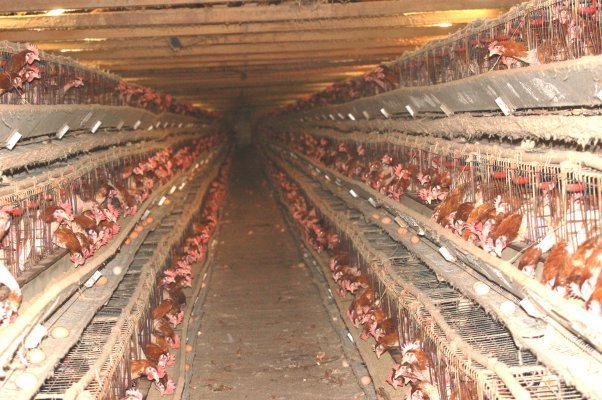By Stephanie Strom, The New York Times, April 11, 2012
 |
| Industrial chicken farming |
A recent test of
packaged raw chicken products bought at grocery stores across the country found
that roughly half of them were contaminated with the bacteria E. coli.
E. coli, which the study said was an indicator of fecal
contamination, was found in 48 percent of 120 chicken products bought in 10
major cities by the Physicians Committee for Responsible Medicine, a nonprofit
group that advocates a vegetarian diet among other things. The study
results were released Wednesday.
“Most consumers do not realize that feces are in the chicken products
they purchase,” said Dr. Neal D. Barnard, president of the group. “Food labels
discuss contamination as if it is simply the presence of bacteria, but people
need to know that it means much more than that.”
Food safety specialists said the findings were a tempest in a chicken
coop, particularly because the test was so small and the E. coli found was not
a kind that threatened public health.
“What’s surprising to me is that they didn’t find more,” said Dr.
Michael Doyle, director of the Center for Food Safety at the University of Georgia.
“Poop gets into your food, and not just into meat — produce is grown in soil
fertilized with manure, and there’s E. coli in that, too.”
Dr. Doyle emphasized that the findings by the nonprofit group were
different from the recent uproar over “pink slime,” the inexpensive filler
containing ammonia gas or citric acid that is often added to ground beef
products to kill E. coli and other bacteria. “That’s an additive,” he said.
Eight billion to nine billion chickens annually are processed for food
in the United States, and the Department of Agriculture requires processors to
do an E. coli test on one of every 22,000 birds slaughtered, or, for small
producers, at least one a week.
The National Chicken Council, a trade group representing chicken
producers, said the Physicians Committee’s test was “disingenuous,” given that
it identified only 57 questionable samples out of about 42 million pounds of
ready-to-cook chicken products in grocery stores every day.
“These findings, not a ‘peer-reviewed’ study, are another misleading
attempt by a pseudo-medical group to scare consumers in hopes of advancing
their goal of a vegan society,” said Dr. Ashley Peterson, vice
president of science and technology at the National Chicken Council.
Dr. Peterson said chicken processing plants “strictly” abide by the
Department of Agriculture’s zero tolerance for visible fecal matter and use
many measures to reduce bacteria levels throughout processing. “When a product
moves through the plant, bacteria levels are reduced many hundreds of times to
a fraction of what was naturally on the bird when it arrived,” she said.
Dirk Fillpot, of the Food Safety and Inspection Service of the
Department of Agriculture, said the study’s findings were not supported by any
science or facts. “It assumes that the presence of generic E. coli could only
come from contact with feces, when that is simply not the case,” he said.
“Additionally, the E. coli identified in the study is not a type that would
make consumers ill.”
Dr. Barnard, who is vegan, insisted that it does. Asked what public
health issues, if any, the testing had exposed, he said: “It’s hard to know.
Some problems caused by fecal contamination can be unexpected.”
He cited recent Canadian research that found that E. coli
bacteria from chickens had caused urinary tract infections that had previously
been attributed to individuals’ own E. coli.
In the physicians study, the samples came from a wide variety of
processors, including Perdue and Pilgrim’s. They were bought in stores
including Kroger, Safeway and Albertsons.
“We have stringent food safety policies in place to maintain the
quality of fresh raw poultry, and these policies are designed to insure we
adhere to proper temperature control, sanitation, hygiene and date marking
practices,” said Mike Siemienas, of Supervalu, which owns an Albertsons in San
Diego where some of the chicken was bought.
Some samples showed higher levels of E. coli than the Department of
Agriculture considers acceptable for carcasses when tested at processing
plants.
But Dr. Catherine N. Cutter, an associate professor and food safety
extension specialist at Pennsylvania State University, said that it was impossible
to know if the higher level of contamination came from the processing plants or
developed as the chicken made its way into the grocery store or during testing.
“There are a lot of things that could come into play that could have
caused the higher microbial loads they found,” Dr. Cutter said. “Without more
information like slaughter dates and shelf life, it’s hard to make a
determination about how or where the higher counts came from.”
If a package sat in a refrigerated case for two or three days, or
spent more time on a loading dock than a processor had anticipated, low levels
of E. coli bacteria could multiply, she said.
“The main thing,” Dr. Cutter said, “is that consumers properly handle
a raw chicken and avoid cross contamination as much as possible and cook it
thoroughly.”
No comments:
Post a Comment